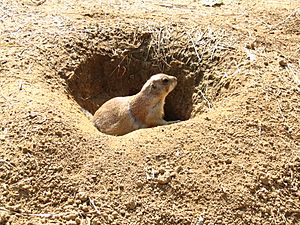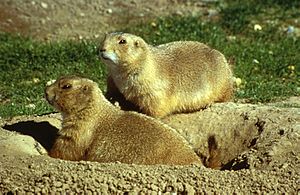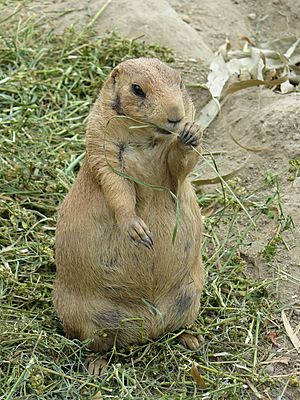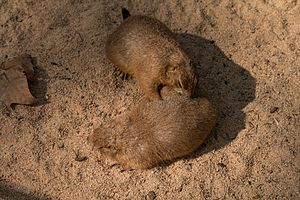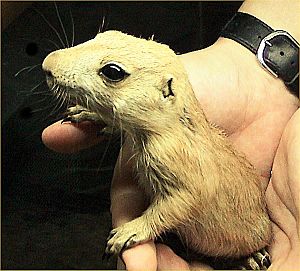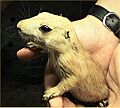Black-tailed prairie dog facts for kids
Quick facts for kids Black-tailed prairie dog |
|
|---|---|
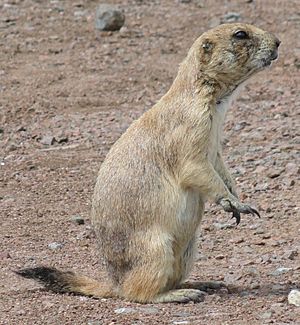 |
|
| At Wichita Mountains Wildlife Refuge | |
| Conservation status | |
| Scientific classification | |
| Genus: |
Cynomys
|
| Species: |
ludovicianus
|
 |
|
| Black-tailed prairie dog range | |
The black-tailed prairie dog (Cynomys ludovicianus) is a type of rodent in the squirrel family. You can find them in the Great Plains of North America. Their home stretches from the United States-Canada border down to the United States-Mexico border.
Unlike some other prairie dogs, these animals do not truly hibernate. You can even see black-tailed prairie dogs above ground in the middle of winter! Long ago, a huge group of black-tailed prairie dogs in Texas was said to cover about 64,000 square kilometers (24,700 square miles). This "town" had an amazing 400,000,000 prairie dogs! Before their homes were destroyed, this species might have been the most common prairie dog in central North America. Explorers Lewis and Clark wrote about this species in their famous journals.
Contents
- What Do Black-Tailed Prairie Dogs Look Like?
- Where Do Black-Tailed Prairie Dogs Live?
- Daily Life and Habits
- Where Do Black-Tailed Prairie Dogs Make Their Homes?
- What Do Black-Tailed Prairie Dogs Eat?
- How Do Black-Tailed Prairie Dogs Live Together?
- Reproduction and Life Cycle
- What Threatens Black-Tailed Prairie Dogs?
- Their Role in the Ecosystem and Threats
- How Are Black-Tailed Prairie Dogs Protected?
- Black-Tailed Prairie Dogs and Livestock
- Prairie Dogs as Pets
- Images for kids
- See also
What Do Black-Tailed Prairie Dogs Look Like?
Black-tailed prairie dogs are usually tan with lighter bellies. Their fur can also have dark black and brown spots on their backs. Their tails have black tips, which is how they got their name.
Adults can weigh from 1.5 to 3.0 pounds (0.7 to 1.4 kg). Males are usually heavier than females. Their bodies are normally 14 to 17 inches (36 to 43 cm) long. Their black-tipped tails are about 3 to 4 inches (8 to 10 cm) long. They have long, black claws that are perfect for digging. Their bodies are compact, and their ears are small and close to their heads.
Where Do Black-Tailed Prairie Dogs Live?
Historically, black-tailed prairie dogs lived from southern Saskatchewan, Canada, down to Chihuahua, Mexico. This area included parts of many US states like Montana, North Dakota, South Dakota, Wyoming, Colorado, Nebraska, Kansas, Oklahoma, Texas, Arizona, and New Mexico.
By 2007, they were still found in most of these areas, except Arizona. However, their populations and the amount of land they live on are much smaller than they used to be.
Daily Life and Habits
Black-tailed prairie dogs are active during the day. They are less active above ground when it's raining or snowing. They also slow down on very hot days, when temperatures go above 100°F (38°C).
During winter, black-tailed prairie dogs do not fully hibernate. They still come out of their burrows to find food. At night, they enter a state called torpor to save energy. Torpor is like a mini-hibernation. Their body processes, heart rate, and breathing slow down. This helps them survive when food is scarce.
On average, they lose about 20% of their body weight during fall and winter. As winter goes on, they spend more time in torpor. If there wasn't much rain the previous year, they might spend even more time in torpor. This is because they get most of their water from the plants they eat.
Where Do Black-Tailed Prairie Dogs Make Their Homes?
Black-tailed prairie dogs are native to the grasslands of North America. They live in shortgrass prairie, mixed-grass prairie, sagebrush steppe, and desert grassland areas.
They choose their homes based on plant cover, ground slope, soil type, and rainfall. Their digging and eating habits change the environment around them. They affect water flow, nutrients in the soil, and the types of plants and animals that can live there.
Ideal Home Conditions
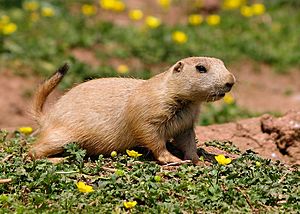
Black-tailed prairie dogs prefer grasslands with short and mixed grasses. They especially like areas that have been grazed by animals like American bison or cattle. Slopes of 2% to 5% are best for them. They like vegetation that is 3 to 5 inches (7–13 cm) tall. This height helps them spot predators and communicate with each other.
In the Great Plains, prairie dog colonies are often found near rivers and creeks. They can also live on hills, flat areas, or even badlands. They can handle a lot of disturbance over time. New colonies rarely start in perfect rangeland. However, land that is heavily grazed for a long time can lose soil, which isn't good.
Prairie dogs might move into heavily grazed areas. They have been found near roads, cattle trails, and places where humans have disturbed the soil.
Soil Preferences for Burrows
Black-tailed prairie dogs can live in many types of soil. What matters more is how soil affects moisture and plants. They prefer soil that won't collapse or flood easily. Silty loam clay soils are best for building their tunnels.
In northern areas, colonies often face south. This is because south-facing slopes have more grass and get more sunlight in winter. Burrows are usually on slopes steeper than 10 degrees. Prairie dogs bring soil from deep underground to the surface. This changes the soil's texture and makeup. Their waste and even their bodies also affect the soil.
How Many Prairie Dogs Live Together?
A group of prairie dogs, called a coterie, usually takes up about 1.0 acre (0.4 hectares). The number of prairie dogs in an area depends on how good the habitat is. Things like hills, soil, tall plants, and social rules can limit their numbers. City growth can also limit colony size. Most flat areas can support at least 13 black-tailed prairie dogs per hectare.
Safe Places to Hide
The burrows are super important for black-tailed prairie dogs. They use them to escape bad weather and hide from predators. Burrows are also where they breed and raise their young. These burrows are used for many generations and help keep the colony stable.
Their nests are underground inside the burrows. They are made of fine, dry grass. Both male and female prairie dogs of all ages collect nest material all year. Tunnels in central Oklahoma are usually 50–60 inches (127–152 cm) deep. Most colonies have 20 to 57 burrows per acre.
There are three types of burrow entrances: dome mounds, rimmed crater mounds, and simple holes. These mounds might help prevent flooding or improve air flow. Dome mounds are made of loose soil spread around the entrance. Rimmed crater mounds are cone-shaped and made of dirt, plants, and other materials. Prairie dogs pack the soil of these mounds with their noses. Simple holes are usually on slopes steeper than 10 degrees.
Short vegetation (3 to 5 inches tall) and gentle slopes (2 to 5 degrees) are best for spotting predators. Cattle grazing helps keep the grass short around colonies. This makes it harder for predators to sneak up. Black-tailed prairie dogs usually don't feed more than 16 feet (5 meters) from the edge of their colony.
What Do Black-Tailed Prairie Dogs Eat?
Black-tailed prairie dogs are picky eaters, but they are also flexible. They choose plants based on what they need. If food is scarce due to drought or grazing, they quickly change their diet.
They prefer grasses over other plants, especially in summer. Grasses can make up more than 75% of their diet. In spring and summer, they like western wheatgrass, buffalo grass, blue grama, and sedges. In late summer and fall, they prefer scarlet globemallow and Russian thistle. In winter, they eat plains prickly pear, Russian thistle, and underground roots. They also eat shrubs like rabbitbrush, winterfat, saltbush, and sagebrush.
They get most of their water from plants like plains prickly pear, since water is often hard to find in the prairie. Sometimes, they even eat insects like cutworms and grasshoppers, or old American bison droppings.
How Do Black-Tailed Prairie Dogs Live Together?
Black-tailed prairie dogs live in large groups called colonies. A colony can have from five to thousands of individuals. These colonies are often divided into smaller areas called wards, based on the land's features. Wards are then split into even smaller groups called coteries.
A coterie is usually made up of one adult male, three to four adult females, and several younger prairie dogs. Members of a coterie are friendly with each other but are hostile to outsiders. After the breeding season, the coterie grows as new young are born.
Moving to New Homes
Prairie dogs might move to new areas for several reasons. These include new plant growth at the edge of the colony or a shortage of unrelated females. Sometimes, older females are bothered by younger prairie dogs. There might also be a natural instinct to move when the colony gets too crowded.
Males usually leave their birth territory 12 to 14 months after they stop nursing. This often happens in May and June, but they can move any time of year. Females usually stay in their birth coterie for their whole lives. Prairie dogs that move between colonies travel about 1.5 miles (2.4 km) from where they were born. Roads and trails can sometimes help them move around.
Amazing Hearing
Black-tailed prairie dogs have special hearing that helps them avoid predators. They can hear very low sounds, which helps them detect predators early, even when they are in their burrows. Their hearing range is from 29 Hz to 26 kHz, and they can even hear sounds as low as 4 Hz.
Talking to Each Other
Scientists like Constantine Slobodchikoff believe prairie dogs use a complex system of calls to describe predators. They say these calls can tell other prairie dogs what kind of predator it is, how big it is, and how fast it's coming. This is like a form of grammar! Slobodchikoff also thinks prairie dogs have calls for things that aren't predators. This suggests they have a very detailed language.
There's a debate about whether their alarm calls are selfish or helpful. Some think prairie dogs call to protect themselves. Others think the calls cause confusion, making others more noticeable to the predator than the caller. Studies suggest that alarm calls help family members, like offspring and cousins. Prairie dogs with family nearby call more often.
When a prairie dog makes a call, others don't usually run into their burrows. Instead, they stand on their mounds to see where the predator is. This makes them visible, but they seem to have trouble figuring out which prairie dog is calling.
One of the most noticeable ways prairie dogs communicate is the "jump-yip" display. A prairie dog stretches its body up tall and throws its front paws in the air while making a call. When one prairie dog does a jump-yip, others nearby often do the same. The prairie dog that starts the "jump-yip wave" uses it to check if its neighbors are alert. A longer jump-yip wave means watchful neighbors, which encourages the first prairie dog to spend more time looking for food.
Reproduction and Life Cycle
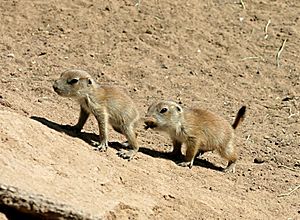
How well black-tailed prairie dogs reproduce depends on how much food is available. This includes when they first start having babies, how many get pregnant, how many babies are in a litter, how fast the young grow, and how many survive their first year.
Mating Habits
Black-tailed prairie dogs usually start breeding at two years old. However, one-year-olds might breed if there's plenty of space and food. In Wind Cave National Park, South Dakota, 9% of one-year-old females successfully raised a litter.
The mating season is from late February through April. The exact timing changes depending on where the colony is located. Females are only able to get pregnant for one day during the breeding season.
Raising Young
In Wind Cave National Park, about 47% of adult females successfully raised a litter each year. Young colonies with room to grow tend to have more successful reproduction and survival rates. For example, in a five-year-old colony with space, 88% of females were pregnant and 81% of young survived. In an old colony (30 years) with no room, 90% of females were pregnant, but only 41% of young survived.
Gestation and Litter Size
Black-tailed prairie dogs are pregnant for 34 days. The babies are born underground. We don't know the exact litter size at birth. However, the average litter size seen above ground is between 3.0 and 4.9 young per litter. They only have one litter each year.
Development of Young Prairie Dogs
In captivity, black-tailed prairie dog pups open their eyes when they are 30 days old. The pups are born helpless and stay underground for up to seven weeks to nurse. They become fully mature at 15 months old.
We don't know the exact lifespan of black-tailed prairie dogs in the wild. However, males older than 3 years often die. Females may live longer than males. Some studies suggest males live about 5 years and females about 7 years.
What Threatens Black-Tailed Prairie Dogs?
Many things can cause black-tailed prairie dogs to die. These include predators, diseases, infanticide (when adults kill young), loss of their homes, poisoning, trapping, and shooting. In Wind Cave National Park, 54% of females and less than 50% of males survived their first year. Young prairie dogs faced the highest death rates from predators in winter and early spring. Moving away from their colony or coterie also increases their risk of death.
A disease called Sylvatic plague, caused by bacteria, can quickly wipe out entire black-tailed prairie dog colonies. Once infected, they die within a few days. They can also get diseases from animals brought into their habitat.
Who Are Their Predators?
The most common predators of black-tailed prairie dogs are coyotes, American badgers, bobcats, golden eagles, ferruginous hawks, red-tailed hawks, and prairie rattlesnakes. Although very rare now, black-footed ferrets used to be a major predator.
Their Role in the Ecosystem and Threats
Black-tailed prairie dogs are sometimes called "ecosystem engineers." This means they greatly influence their habitat and the plants and animals living there. They help increase the variety of plants, vertebrates (animals with backbones), and invertebrates (animals without backbones). They do this through their digging and foraging. Grasslands with prairie dogs have more biodiversity than those without them.
Hundreds of species of animals are linked to black-tailed prairie dog colonies. The number of different vertebrate species increases with the size and density of the colony. In Montana, 40% of all vertebrate animals in prairie habitats rely on prairie dog colonies for food, nesting, or dens. Rare animals like the black-footed ferret, swift fox, mountain plover, and burrowing owl are found near these colonies.
Because prairie dogs keep plants short and nutritious, herbivores like American bison, pronghorn, and domestic cattle often prefer to eat in prairie dog colonies. However, animals that need tall plant cover, like mule deer and sage grouse, might avoid these areas.
The variety of life in shortgrass prairies is at risk because black-tailed prairie dog numbers are shrinking. Threats include their habitat being broken up or lost, efforts to get rid of them, and sylvatic plague. Due to these issues, colonies are now smaller and more spread out than they once were. Farming, livestock use, and other development have reduced their habitat to only 2% of its original size. Smaller, separated colonies are more likely to be wiped out, especially by plague. The effect of roads on prairie dogs is debated. Roads might help them move or block them, depending on the area. Busy roads can increase deaths, but roads, streams, and lakes might also act as barriers to the spread of plague.
How Are Black-Tailed Prairie Dogs Protected?
Black-tailed prairie dogs are often seen as pests on ranchland and are killed. Their homes have been broken up, and their numbers have dropped a lot. Also, they are very vulnerable to the plague. In 2006, every time plague appeared in a black-tailed prairie dog colony, the whole colony was lost.
Studies in 1961 estimated only about 364,000 acres (1,473 square kilometers) of black-tailed prairie dog habitat in the United States. A study in 2000 showed about 676,000 acres (2,736 square kilometers). However, a big study in 2004 found about 1,842,000 acres (7,454 square kilometers) in the United States. There were also about 51,589 acres (209 square kilometers) in Mexico and Canada. Because of these 2004 studies, the US Fish and Wildlife Service removed the black-tailed prairie dog from the list of species being considered for the Endangered Species Act in August 2004.
Black-Tailed Prairie Dogs and Livestock
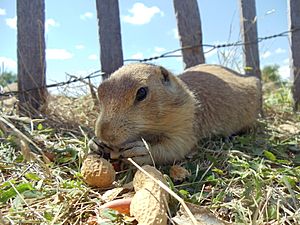
People often think black-tailed prairie dogs compete with livestock for food. However, the effects on rangelands are mixed. Some research suggests they have no effect or even a good effect on land used by livestock.
In some areas, there were differences in plants between prairie dog colonies and areas without them. But the overall types of plants didn't change much. Cattle didn't seem to prefer or avoid prairie dog colonies. They grazed just as much on colonies as on other areas.
It's not clear if prairie dogs and livestock compete for the same food. Some studies say prairie dogs avoid many plants that livestock like, and prefer plants that livestock avoid. But other studies show that cattle and prairie dogs had similar diets.
Some changes in plants caused by prairie dogs might actually help livestock. They encourage plants that can handle grazing better, like needleleaf sedge, sixweeks grass, and scarlet globemallow. Prairie dog grazing might also make some plants more nutritious. In one area, plant diversity was greater inside prairie dog colonies. Perennial grasses and other plants increased. Even though there was less food available for cattle in prairie dog areas, the weight of steers (young male cattle) was not significantly reduced. This is because prairie dogs help cycle nutrients and improve soil fertility, which makes the remaining plants more nutritious.
Prairie Dogs as Pets
Black-tailed prairie dogs used to be the most common prairie dog species caught from the wild to be sold as exotic pets. However, this trade was banned in 2003 by the United States federal government. Prairie dogs already owned at the time of the ban were allowed to be kept. But no more could be caught, traded, or sold. Moving them was only allowed for vet visits under strict rules. The ban was officially lifted on September 8, 2008.
Images for kids
See also
 In Spanish: Perrito de la pradera de cola negra para niños
In Spanish: Perrito de la pradera de cola negra para niños



